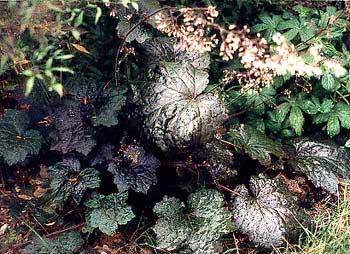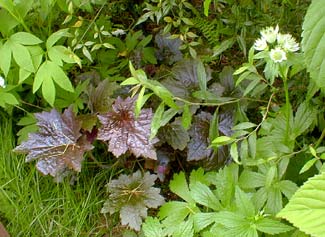
'Purple Palace' Alumroot or Heuchera
"We humans -
squirming around
among the blossoming flowers."
-Kobayashi Issa
(1763-1827)
(1763-1827)
This alumroot (Heuchera micrantha var diversifolia 'Purple Palace') took two years to establish well, until which time I had been rather disappointed in it. But when finally deeply established, it became more than commonly appealing.
Though grown primarily for the sake of its glistening mahogany leaves rather than for the flowers, even the panical sprays of tiny faintly pinked white blooms become substantial additions throughout the summer.
They do well in a wide variety of conditions but prefer moist rich well drained soil in light shade (more shade the further south they are grown).
We planted two specimens, one in an afternoon-sunny spot that was occasionally a bit dry, the other in a shady spot practically underneath a Nandina shrub & generally kept moist. The photo above is the one undernearth the Nandina, shown in July (2002), & the second photo is from May (2003). The green leaves to the right is the edge of a clump of Masterwort, one of its flowers captured in the second photo.
 For a while during the long time it took both specimens to establish, it seemed the one in the sun was growing faster & more attractively, but in the long run they both developed the exact degree of shiny purple leaves under sprays of off-white flowers. The one grown in shade eventually became the better-looking of the two clumps.
For a while during the long time it took both specimens to establish, it seemed the one in the sun was growing faster & more attractively, but in the long run they both developed the exact degree of shiny purple leaves under sprays of off-white flowers. The one grown in shade eventually became the better-looking of the two clumps.Derived from a Pacific Northwest native perennial, several cultivars are today well known throughout temperate gardening zones, with 'Purple Palace' the most popular. There are gaudier-leafed cultivars of H. micrantha, including some that are extremely ruffled, & one ('Purple Passion') that approaches a crayon-purple leaf. Others are variegated, or deeply veined, plus hybrids continually extend the varieties that reach the marketplace. Such variety is extraordinary for a plant that started out as a grey-green weed with flowers so unassuming it was called the Small Flowering Alum Root.
Of the many varieties, I find the mahagony of 'Purple Palace' to be one of the most tasteful & best, with a little of the gothic in its flirtation with blackness. But I do not feel any of the fancy-leafed heucheras are quite as charming as they could be, & I use them more as fill-in to break up mixed leaf textures, & have given up on any expectation of their looking sufficiently perfect to be a primary center of attention.
In 1991 it was chosen by the Perennial Plant Association as the Perennial Plant of the Year. This professional organization's criteria include garden-worthy beauty, easy to grow, but not too easy to propagate insuring its long-term profitability to professional growers. Flowers that too easily reproduce on their own don't require professional growers, but are traded among gardeners who save seeds. 'Purple Palace' can be a but difficult to propagate in a small gardens, though very easy in large commercial fields.
Seeds selected from ideal specimens with the handsomest leaves tend to grow true to the parent. But flowers are often sterile & 'Purple Palace' requires many plants in a group before the essential cross-polinization occurs. In a small garden it would be easier to propagate by division every few years, which results in a very limited number of plants since the clump does not widen swiftly. It can also be started from leaf-node cuttings.
Vastly more signficant than its honor from the leading professionals' perennial association, 'Purple Palace' was also honored with the Award of Garden Merit by the Royal Horitcultural Society. This is given to plants that have proven themselves over time to be hardy, beautiful, & easily cared for.
When well established it bushes up to a foot & a half or so, forming a very rounded clump with a tidy compact appearance. If unprotected it can die back in winter especially in USDA zones 4 through 6. But ours has proven to be evergreen on Puget Sound (zone 8), though it is not its best looking by the end of winter & needs trimming ahead new spring growth.
Established plants are fairly drought tolerant, nor will it die in poor soil, but in such imperfect conditions it will not be as attractive. With richly organic content in its soil it gets its fluffiest & most shimmering.